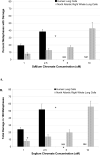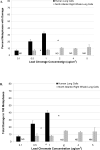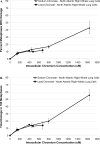Cytotoxicity and genotoxicity of hexavalent chromium in human and North Atlantic right whale (Eubalaena glacialis) lung cells
- PMID: 19632355
- PMCID: PMC4048704
- DOI: 10.1016/j.cbpc.2009.07.004
Cytotoxicity and genotoxicity of hexavalent chromium in human and North Atlantic right whale (Eubalaena glacialis) lung cells
Abstract
Humans and cetaceans are exposed to a wide range of contaminants. In this study, we compared the cytotoxic and genotoxic effects of a metal pollutant, hexavalent chromium [Cr(VI)], which has been shown to cause damage in lung cells from both humans and North Atlantic right whales. Our results show that Cr induces increased cell death and chromosome damage in lung cells from both species with increasing intracellular Cr ion levels. Soluble Cr(VI) induced less of a cytotoxic and genotoxic effect based on administered dose in right whale (Eubalaena glacialis) cells than in human (Homo sapiens) cells. Whereas, particulate Cr(VI) induced a similar cytotoxic effect but less of a genotoxic effect based on administered dose in right whale cells than in human cells. Differences in chromium ion uptake explained soluble chromate-induced cell death but not all of the soluble chromate-induced chromosome damage. Uptake differences of lead ions could explain the differences in particulate chromate-induced toxicity. The data show that both forms of Cr(VI) are less genotoxic to right whale than human lung cells, and that soluble Cr(VI) induces a similar cytotoxic effect in both right whale and human cells, while particulate Cr(VI) is more cytotoxic to right whale lung cells.
Figures











Similar articles
-
Particulate and soluble hexavalent chromium are cytotoxic and genotoxic to human lung epithelial cells.Mutat Res. 2006 Nov 7;610(1-2):2-7. doi: 10.1016/j.mrgentox.2006.06.005. Epub 2006 Jul 26. Mutat Res. 2006. PMID: 16872863
-
The clastogenic effects of chronic exposure to particulate and soluble Cr(VI) in human lung cells.Mutat Res. 2006 Nov 7;610(1-2):8-13. doi: 10.1016/j.mrgentox.2006.06.006. Epub 2006 Jul 25. Mutat Res. 2006. PMID: 16870495
-
Comparative cytotoxicity and genotoxicity of particulate and soluble hexavalent chromium in human and sperm whale (Physeter macrocephalus) skin cells.Comp Biochem Physiol C Toxicol Pharmacol. 2012 Jan;155(1):143-50. doi: 10.1016/j.cbpc.2011.03.011. Epub 2011 Apr 3. Comp Biochem Physiol C Toxicol Pharmacol. 2012. PMID: 21466859 Free PMC article.
-
Assessment of the mode of action for hexavalent chromium-induced lung cancer following inhalation exposures.Toxicology. 2014 Nov 5;325:160-79. doi: 10.1016/j.tox.2014.08.009. Epub 2014 Aug 28. Toxicology. 2014. PMID: 25174529 Review.
-
Carcinogenic Mechanisms of Hexavalent Chromium: From DNA Breaks to Chromosome Instability and Neoplastic Transformation.Curr Environ Health Rep. 2024 Dec;11(4):484-546. doi: 10.1007/s40572-024-00460-9. Epub 2024 Oct 28. Curr Environ Health Rep. 2024. PMID: 39466546 Review.
Cited by
-
Metal Levels in Whales from the Gulf of Maine: A One Environmental Health approach.Chemosphere. 2019 Feb;216:653-660. doi: 10.1016/j.chemosphere.2018.10.120. Epub 2018 Oct 18. Chemosphere. 2019. PMID: 30391886 Free PMC article.
-
Comparative cytotoxicity and genotoxicity of soluble and particulate hexavalent chromium in human and hawksbill sea turtle (Eretmochelys imbricata) skin cells.Comp Biochem Physiol C Toxicol Pharmacol. 2015 Dec;178:145-155. doi: 10.1016/j.cbpc.2015.09.013. Epub 2015 Oct 9. Comp Biochem Physiol C Toxicol Pharmacol. 2015. PMID: 26440299 Free PMC article.
-
Chromium Is Elevated in Fin Whale (Balaenoptera physalus) Skin Tissue and Is Genotoxic to Fin Whale Skin Cells.Biol Trace Elem Res. 2015 Jul;166(1):108-17. doi: 10.1007/s12011-015-0311-x. Epub 2015 Mar 26. Biol Trace Elem Res. 2015. PMID: 25805270 Free PMC article.
-
A whale of a tale: whale cells evade the driving mechanism for hexavalent chromium-induced chromosome instability.Toxicol Sci. 2024 Apr 29;199(1):49-62. doi: 10.1093/toxsci/kfae030. Toxicol Sci. 2024. PMID: 38539048 Free PMC article.
-
Derivation and characterization of cell cultures from the skin of the Indo-Pacific humpback dolphin Sousa chinensis.In Vitro Cell Dev Biol Anim. 2013 Jun;49(6):449-57. doi: 10.1007/s11626-013-9611-7. Epub 2013 May 10. In Vitro Cell Dev Biol Anim. 2013. PMID: 23661087
References
-
- Agency for Toxic Substances and Disease Registry (ATSDR) Toxicological profile for Chromium. U.S. Department of Health and Human Services, Public Health Service, Agency for Toxic Substances and Disease Registry; Atlanta, GA: 2008.
-
- Al-Hamood MH, Elbetieha A, Bataineh H. Sexual maturation and fertility of male and female mice exposed prenatally and postnatally to trivalent and hexavalent chromium compounds. Reprod. Fertil. Dev. 1998;10:179–183. - PubMed
-
- Bataineh H, Al-Hamood MH, Elbetieha A, Bani Hani I. Effect of long-term ingestion of chromium compounds on aggression, sex behavior and fertility in adult male rat. Drug Chem. Toxicol. 1997;20:133–149. - PubMed
-
- Chowdhury AR, Mitra C. Spermatogenic and steroidogenic impairment after chromium treatment in rats. Indian J. Exp. Biol. 1995;33:480–484. - PubMed
-
- Chung YS. Air pollution detection by satellites: The transport and deposition of air pollutants over oceans. Atmos. Environ. 1986;20:617–630.
Publication types
MeSH terms
Substances
Grants and funding
LinkOut - more resources
Full Text Sources

